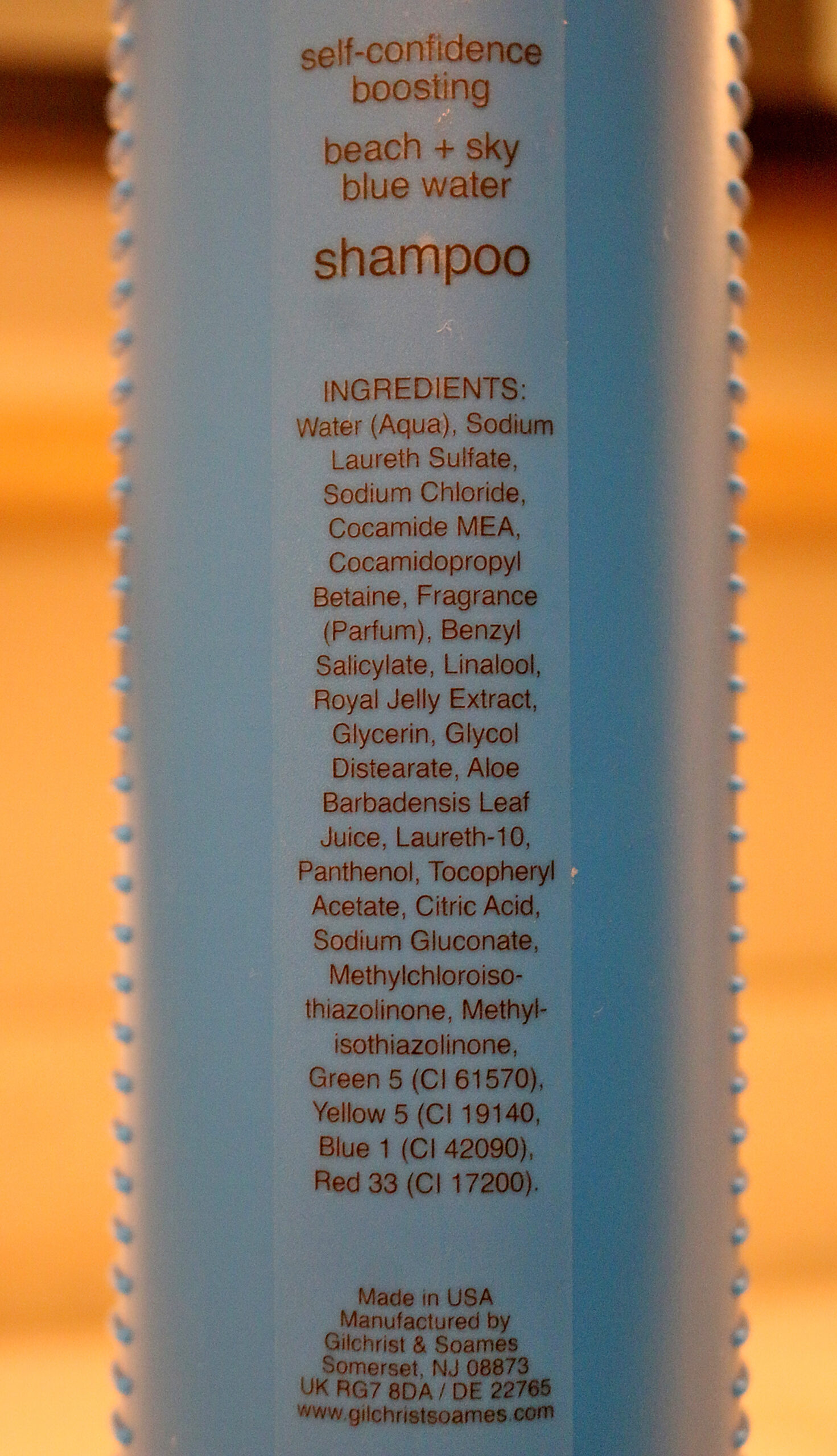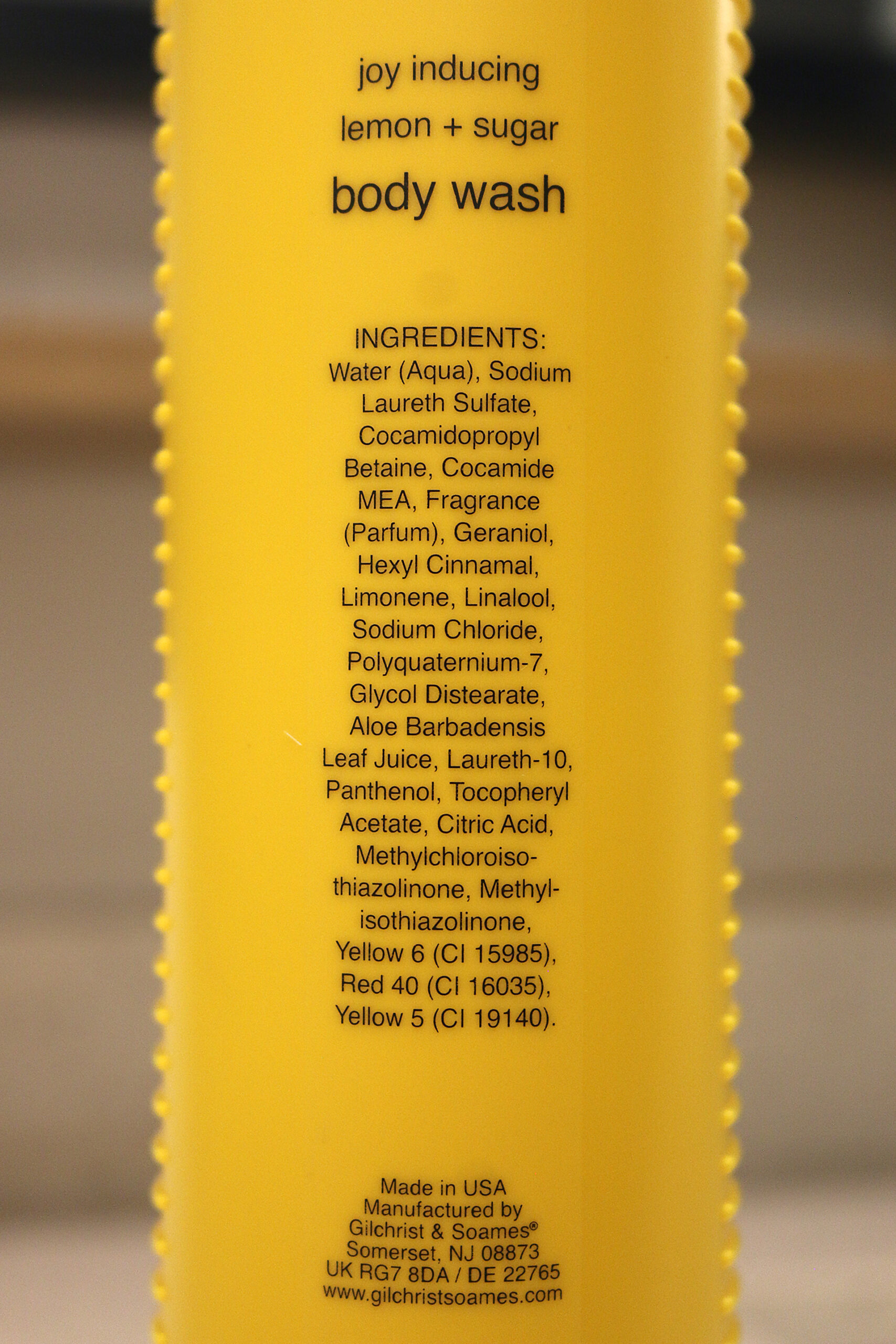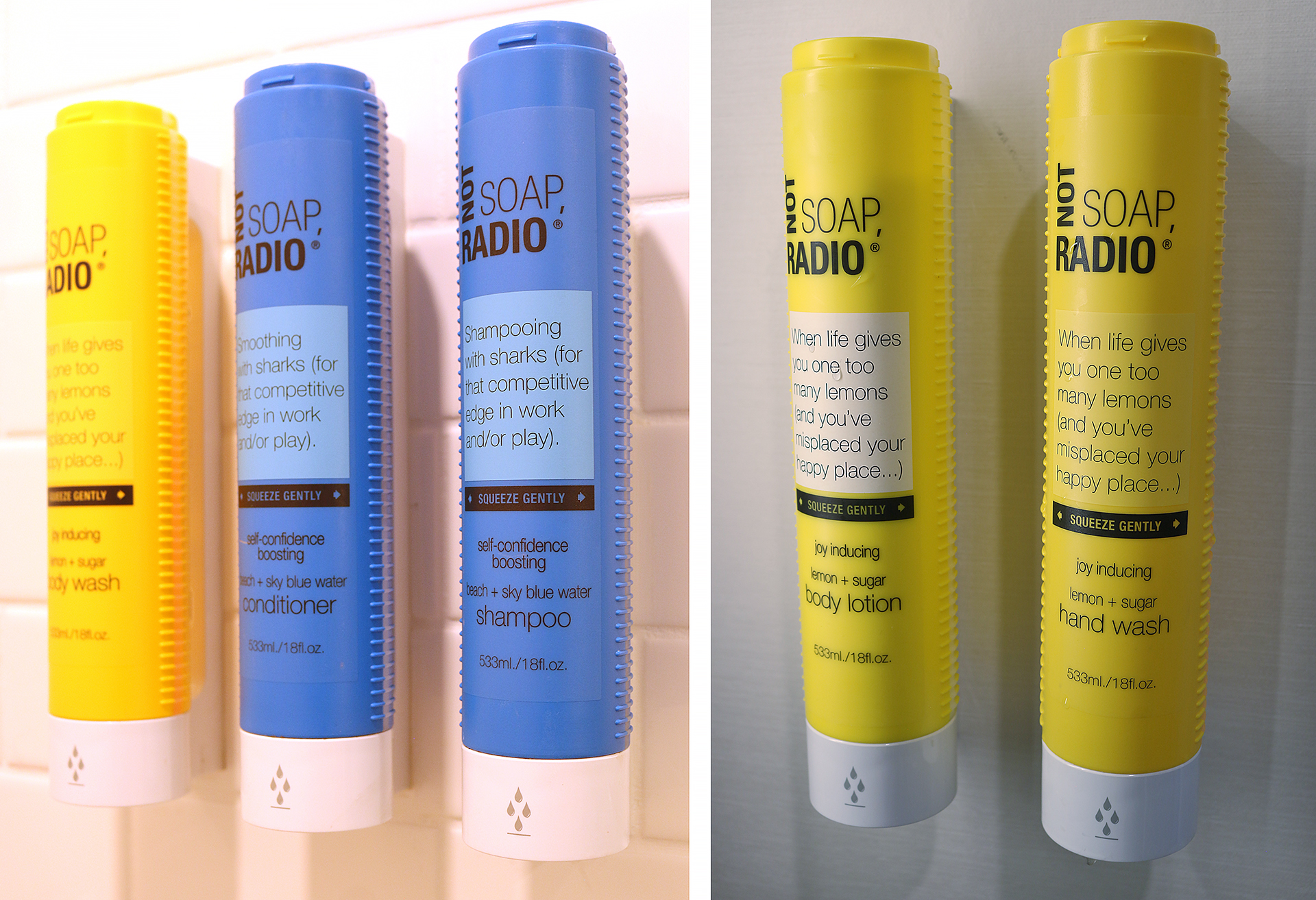One result of the conversion from single use plastic toiletry and amenity bottles to bulk dispensers at hotel and resort properties is that the bulk dispensers have plenty of room to list the ingredients of the products that are within them — but what ingredients are in shampoo and body wash?
What Ingredients Are In Shampoo and Body Wash?
As an example, both the Tru By Hilton Oklahoma City Airport and Tru by Hilton Denver Downtown Convention Center hotel properties feature amenities in bulk dispensers with the brand name of Not Soap, Radio, which is supposedly a form of practical joke and an example of surreal comedy which I neither found funny or simply just did not get the joke.
I also did not like how the product came out of the containers, as you have to squeeze both sides of the container itself for it to come out. Squeeze gently as instructed, and nothing happens; but too much came out when squeezing slightly less gently. Despite multiple attempts, I could not find a happy medium. The container is poorly designed overall.
I found the statements printed on the labels of the containers to be both vapid and vacuous at best: “When life gives you one too many lemons and you’ve misplaced your happy place” and “Shampooing with sharks (for that competitive edge in work and/or play).”
Huh?!?
Both the shampoo and the body wash contain the following ingredients:
- Water (Aqua) is a transparent, tasteless, odorless liquid. Yes — that water.
- Sodium Laureth Sulfate is an inexpensive and very effective foaming agent that is derived from palm kernel oil or coconut oil.
- Sodium Chloride is the chemical name for salt.
- Cocamide MEA is also known as cocamide monoethanolamine, which is used as a foaming agent and as a nonionic surfactant in shampoos and bath products.
- Cocamidopropyl Betaine is an amphoteric synthetic detergent that has been increasingly used in cosmetics and personal hygiene products because it induces relatively mild skin irritation.
- Fragrance (Parfum) is a mixture of fragrant essential oils or aroma compounds or fragrances, fixatives, and solvents — usually in liquid form — that are used to give the shampoo an agreeable scent.
- Linalool is used to add odor and flavor to products.
- Glycol Distearate is used to produce pearlescent effects in shampoo — that is, having a luster that resembles mother-of-pearl — and it can also be used as a moisturizer.
- Aloe Barbadensis Leaf Juice is basically the liquid from an Aloe vera plant.
- Laureth-10 is an oil-in-water emulsifier which cleanses hair and skin.
- Panthenol is used as a moisturizer.
- Tocopheryl Acetate is a synthetic form of Vitamin E. The Centers for Disease Control and Prevention of the United States claimed that vitamin E acetate is a very strong culprit of concern in the 2019 outbreak of vaping-associated pulmonary injury — but there is not yet sufficient evidence to rule out contributions from other chemicals.
- Citric Acid is used to reduce acidic pH levels, which improves the appearance and manageability of hair by reducing frizz.
- Sodium Gluconate is used as a natural preservative that prevents the growth of microbes in products to keep them safe It also works as a chelator which helps cleansing products to foam better in hard water.
- Methylchloroisothiazolinone is an organic compound that is effective against gram-positive bacteria and gram-negative bacteria, yeast, and fungi — but it can cause allergic reactions in some people.
- Methylisothiazolinone is an organic compound which is used as a biocide that controls microbial growth in solutions that contain water. Kathon is created when methylchloroisothiazolinone is mixed with methylisothiazolinone, which can cause contact dermatitis.
- Yellow 5 (Cl 19140) is also known as tartrazine, which is a synthetic lemon yellow azo dye that is primarily used as a coloring for food and cosmetics.

Other ingredients of the shampoo — which has a “self-confidence boosting” scent called beach + sky blue water — are as follows:
- Benzyl Salicylate is a salicylic acid benzyl ester that occurs naturally in a variety of plants and plant extracts. It is widely used in blends of fragrance materials.
- Royal Jelly Extract is a secretion from honey bees which results in supple skin that is nourished and moisturized. It may cause allergic reactions in humans — ranging from hives to asthma to even fatal anaphylaxis.
- Glycerin is a colorless, odorless, viscous liquid that tastes sweet and is not toxic that improves smoothness of skin, provides lubrication, and is used as a humectant.
- Green 5 (Cl 61570) is a synthetic dye that is produced from petroleum sources or coal tar sources and used in pharmaceuticals and cosmetics.
- Blue 1 (Cl 42090) is also known as Brilliant Blue FCF, which is a synthetic organic compound that is used primarily as a blue colorant for processed foods, medications, dietary supplements, and cosmetics.
- Red 33 (Cl 17200) is also known as Acid Red 33, which is a red azo dye that is used as a colorant in mouthwashes, dentifrices, cosmetics, and hair dyes.
I was indifferent to the fragrance of beach + sky blue water.

The body wash has a “joy inducing” scent called lemon + sugar, whose ingredients also include:
- Geraniol is a monoterpenoid and an alcohol that is the primary component of citronella oil, rose oil, and palmarosa oil.
- Hexyl Cinnamal is found naturally in the essential oil of chamomile. It is known to cause contact allergies in some individuals — but the rate of incidence is low.
- Limonene is the major component in the volatile oil of the peels of citrus fruits which can help improve the health and repair of hair by protecting it from damage, encouraging growth, moisturizing it, strengthening it, and reducing inflammation.
- Polyquaternium-7 is used as modifier in which absorption of moisture from the air lends “conditioning” properties to shampoos and other products that contain the copolymer.
- Yellow 6 (Cl 15985) is also known as Sunset Yellow, which is an orange azo dye that is derived from petroleum and used in foods, condoms, cosmetics, and drugs.
- Red 40 (Cl 16035) is also known as Allura Red AC, which is a red azo dye that is used in foods, cosmetics, and drugs. Chronic exposure to this dye has been shown to increase susceptibility to bowel disorders in mice.
The smell of lemon + sugar was so sickeningly sweet that my teeth felt like they were rotting — and lemon is one of my favorite scents.
Final Boarding Call
The list of ingredients is a list of chemical compounds that can sound frightening — to the point of one asking “What am I putting in my hair and on my skin?!?” — but then again, one can also ask that about much of the food we consume and what we are putting inside of our bodies. As scary as they sound, most of the ingredients are considered harmless.
Some of the ingredients are actually quite common in other shampoos and body washes — such as Cocamidopropyl Betaine, Cocamide MEA, Sodium Chloride, and Linalool. Water is almost always the first ingredient. Unless the ingredients of the shampoo or body wash are unique, you can pretty much shop on price or by fragrance.

Also, many companies list the ingredients of their products at their official Internet web sites. For example, the White Vetiver fragrance of Apotheke shampoo, conditioner, and bath gel is featured at the Tempo by Hilton New York Times Square hotel property; and the ingredients are listed here.
- Aqua/Water/Eau
- Sodium Laureth Sulfate
- PEG-4 Rapeseedamide
- Sodium Chloride
- Cocamidopropyl Betaine
- Parfum (Fragrance)
- DMDM Hydantoin
- Glycol Distearate
- Steareth-4
- PEG-7 Glyceryl Cocoate
- Polysorbate 20
- Glycerin
- Citric Acid
- Disodium EDTA
- Octadecyl di-t-butyl-4-hydroxyhydrocinnamate
- Aloe Barbadensis Leaf Juice
- Cocos Nucifera (Coconut) Oil
- Simmondsia Chinensis (Jojoba) Seed Oil
- Tocopheryl Acetate
- Alcohol
- Chondrus Crispus (Carrageenan)
- Canola Oil, Chamomilla Recutita (Matricaria) Flower Extract
- Althaea Officinalis Root Extract
- Camellia Sinensis Leaf Extract
- Symphytum Officinale Root Extract
Although this article picks on Not Soap, Radio, at least the full list of ingredients of each product is displayed on each bulk dispenser so that consumers at least have an idea of what they are using whenever they are guests in a Tru by Hilton hotel property — which is good. Most of the ingredients are considered harmless; but some guests may be prompted to travel with their preferred brands of shampoo and body wash anyway.
I compiled this list more to satisfy my own curiosity than for any other reason…
All photographs ©2023 by Brian Cohen.

